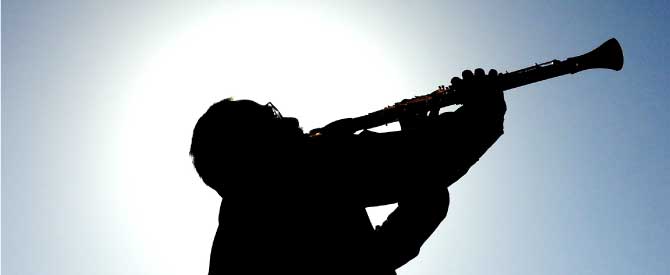From the arguments set out so far, it follows that phenomenology unlocks the philosophical message of the composer, contained and coded in a score.In orchestral works, the final responsibility lies with the conductor through his or her instrument, which is the orchestra.
As creating, performing and listening to music has always been a basic need in human beings, the questions that arise when performing and receiving this message are as follows:
To what extent is this message decoded and to what extent does it coincide with the intentions of the composer?
The responses will always depend on the professional competence of the conductor and of the teachers who form part of the orchestra. (9)
Therefore, to sum up, the group of people who generate the music are the composer, through his/her composition, the performer as the conduit through which the music is channelled and decoded, and lastly, the receiver or listener.
The more experiences or references the performer and the listener have, the more they will understand the message locked up a composition (resulting experiences).
The reference represents the creative capacity of man to measure the process of expansion or comprehension of music.One sound is nothing; two sounds (an interval) already create a system of reference and orientation.
This reference system is not conscious, it is a measurement process and therefore of intellectual reference.Thus it can be said that the reference system represents a starting point.
In order to determine and quantify the level of "musical" understanding, phenomenology uses terms such as:meaning and values.
A) Meaning (10)
The questions generated by the concept contained in the "meaning of music" are as follows:Does it refer to real events?Is music an ethereal, auditory material? (11)
What does it represent?The response would be:the meaning of music represents an association between the organized, harmonic-tonal reality and the philosophical message contained in the composition.
For this reason, in order to determine the meaning of a composition, we use terms such as:“expresses”, “symbolizes” or “represents”, with special reference to feelings or images. (12)
B) Values
For the meaning to make sense we use the values we attribute to the composition. (13)
In order to highlight these values, orchestral performers and conductors must have a knowledge and command of the components and use these in the application of orchestral practice, interrelated with the philosophical branch of music phenomenology.
The values we attribute to compositions in order to quantify their meaning are as follows:
1. Tonal
2. Harmonic
3. Textural
4. Dynamic
5. Temporal
6. Structural
In short, there is no doubt that, for most people, music is simply beautiful.
This phenomenological process represents a set of elements that exercise a certain amount of influence on human consciousness. This influence is called vertical pressure. In music this is associated with harmonies.
If there is vertical pressure, logically there must also be horizontal pressure. (14)
The group of elements that work in a successive manner, determined by the real time factor on human consciousness, is called horizontal pressure and is associated with melodic lines.
----
9. If the role played by social and technical evolution in the development of the creative genius is accepted, if the phenomenon of culture as an apparently continuous dialectic process is obtained and if the importance of the "environment" and the "epoch" that determine the creative training of each generation, stimulating at the same time the type and spirit of the following generation is recognised, one should not fail to understand that in spite of all the "preparations", the appearance of a great creator is always an unexpected and unforeseen event.
There are many things that prove this thesis: Debussy the unexpected one, for example, although conditioned by Wagner. The vocabulary of Debussy, in effect, could only take shape following the chromatic evolution of Wagner; his aesthetic is inconceivable without the external reactions that provoked in him the ascetic of his predecessor. Debussy is the true successor of Wagner, and not those that remodelled Tetralogies. The reaction of Webern with Mahler is no less significant in their surprising and profound affiliation. (Pierre Boulez. Points of reference Editorial Gedisa, S. A., Barcelona 2001).
10. For this composer music means a practical action that responds to a commitment between intuitive thought and synchronisation through a material and a number of specific notation-production means. Del Campo P. Coord. Music as a human process. Music and the human creative process. Author Sir Yehudi Menuhin. Amarú Ediciones, Salamanca, 1997.)
11. The phenomenon of music requires "specialised" thought. Is the mechanism of creation as important for "living", in other words, to make the necessary choices? Generally, musical creation is considered not so much in its operation as in the targets that are sought, which takes the form of a question that is both simple and terrifying: What did you wish to express?
When we write a work we use a coherent assembly of morphological and syntactical functions; we see ourselves forced at each moment to provide evidence of taste. (Pierre Boulez. Points of reference Editorial Gedisa, S. A., Barcelona 2001).
12 Bertrand Russell gives an eloquent account of the value of philosophy: Philosophy should not be studied in order to obtain defined responses to its questions (as usually specific answers that turn out to be correct cannot be found) but for the questions themselves, as these broaden our conception of what is possible. (Lewis Rowell. Thinking about Music. 1983. The University of Massachusetts Press, Amherst).
13. Husserl (Edmund). German philosopher of Jewish origin, born in Prossnitz and died in Friburg in Brisgovia (1859-1938). He was a teacher of Philosophy at the Universities of Gotinga and Friburg in Brisgovia and one of the most important promoters of the so-called phenomenology, which for him was consistent with the description of the immediate data of consciousness. It involves, therefore, determining the very same structures of the activity of the conscience, which he called essences. Unlike the Platonic conception, these essences do not exist in a separate world; they are data of the relationship between consciousness and things. Some of his most important works are: Logical Investigations (1900), Ideas for a pure phenomenology (1913), and Cartesian meditations (1931). (Espasa Dictionary, several authors, Editorial Espasa-Calpe, S. A., Madrid, 1980).
14. Every time a piece of music is played, several factors come into play, which make the interpretation develop in a different way, in accordance with the interpretative style, the acoustic conditions, etc. A composer can get an idea or how a musical piece will sound only when he has it in his mind. While it is there he can do what he wants with it. It is a purely personal creation. But as soon as the composer has finished the score, the piece is subjected to other laws. As a conductor one must be aware of that. In this sense, there must be a perfect balance between creation (the preconceived idea about how the music should sound) and its subsequent interpretation. (Daniel Barenboim. Daniel Barenboim. 1992 Javier Vergara Editor S.A. Argentina)






